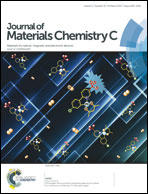Raman scattering and photoluminescence investigation of YBO3:Eu3+ under high temperature and high pressure†
Abstract
Raman scattering, X-ray diffraction and photoluminescence spectra of YBO3:Eu3+ are measured at high temperatures up to 1323 K. Results show that a temperature-induced phase transition from the LT to the HT phase starts at about 1273 K, then the HT phase transforms into the LT phase on cooling to 873 K. A theoretical model based on a luminescent dynamic process describes the temperature-dependent emission intensity well. In this model, the contributions from thermal activation, phonon-assisted absorption, and nonradiative energy transfer are analyzed in detail. In addition, we report the structure and optical behavior of YBO3:Eu3+ under high pressure by means of Raman scattering and photoluminescence measurements. When pressure is increased from zero to 25 GPa, Raman and photoluminescence measurements show that the structure of YBO3:Eu3+ remains stable and no pressure-driven phase transition occurs throughout the entire pressure range of these experiments. In addition, the mode-Grüneisen parameters and thermal expansion coefficient are calculated.


 Please wait while we load your content...
Please wait while we load your content...